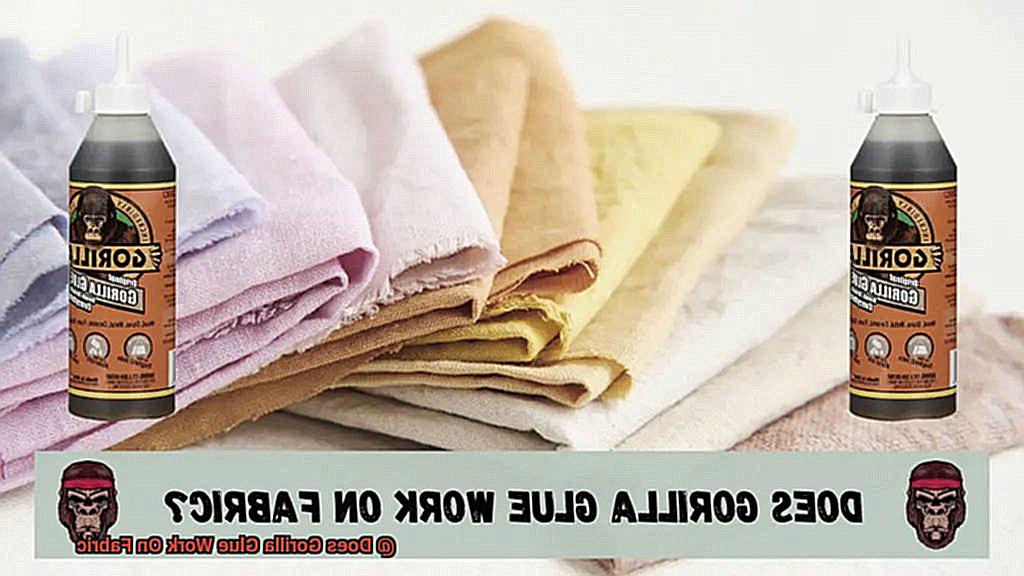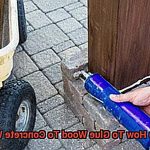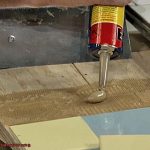Have you ever been heartbroken over a tear in your favorite clothing item? You know the one that fits just right and makes you feel like a million bucks? If so, you may have considered using glue to fix it. But can Gorilla Glue work on fabric?
Gorilla Glue is known for its strength and versatility. It’s a go-to adhesive for many DIY projects, but can it hold up on fabric? The answer is yes, but there are some important things to keep in mind.
Firstly, Gorilla Glue cures to a hard and rigid finish which can be problematic if you’re trying to repair stretchy or flexible fabrics. Secondly, the glue expands as it cures which means you need to use it sparingly to avoid making a mess.
Despite these challenges, Gorilla Glue can be a lifesaver when it comes to repairing fabrics. Whether you’re looking to save your favorite sweater or patch up your go-to jeans, Gorilla Glue can help.
In this post, we’ll dive deeper into how Gorilla Glue works on fabric and what you need to know for the best results. So grab your ripped clothing items and let’s get started.
Advantages of Using Gorilla Glue on Fabric
Contents
- 1 Advantages of Using Gorilla Glue on Fabric
- 2 Disadvantages of Using Gorilla Glue on Fabric
- 3 Types of Fabric That Can Benefit from Gorilla Glue
- 4 Types of Fabric That Should Not Be Bonded with Gorilla Glue
- 5 Tips for Working with Gorilla Glue and Fabric
- 6 Alternatives to Using Gorilla Glue on Fabric
- 7 Conclusion
Say goodbye to fabric woes with the help of Gorilla Glue – the versatile and affordable adhesive that can fix all your fabric troubles. There are numerous advantages to using Gorilla Glue on fabric, making it a go-to choice for all your bonding needs.

One significant advantage of using Gorilla Glue on fabric is that it dries clear, leaving no visible residue. This means you can repair tears, holes, and rips in clothing without compromising the appearance of the garment. No one will know it was ever damaged.
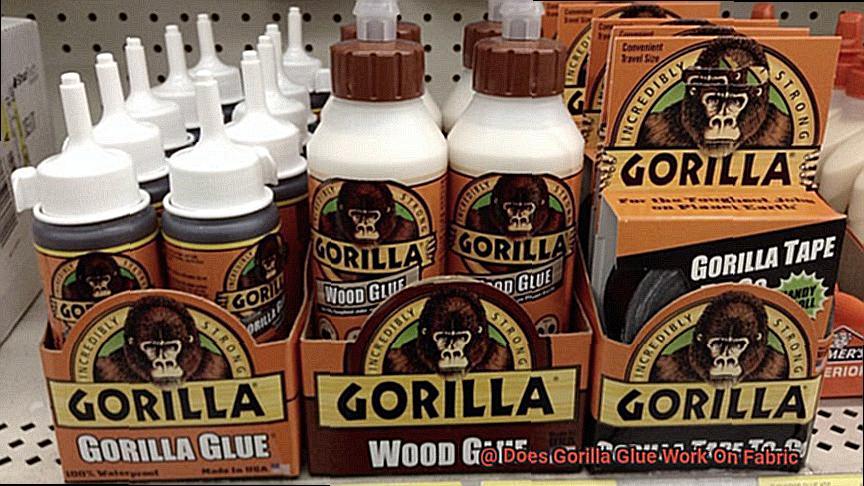
Not only is Gorilla Glue strong and effective, but it is also waterproof once it dries. This feature makes it ideal for outdoor fabrics such as tents, patio furniture covers, and awnings. So go ahead and repair that torn tent with confidence – knowing it will hold up even in wet conditions.
Gorilla Glue is versatile and can bond a wide range of fabrics, including cotton, denim, polyester, leather, canvas, and burlap. This means you can use it to fix upholstery, curtains, bedding, and various other fabric items around your home. The possibilities are endless.
One of the best things about Gorilla Glue is that it dries quickly. Unlike traditional fabric glue or sewing methods that require time to dry or stitch together, Gorilla Glue bonds instantly and creates a strong hold within minutes. You’ll be amazed at how quickly you can get back to wearing your favorite clothes or using your favorite gear.
Lastly, Gorilla Glue is affordable and readily available at most hardware stores and online retailers. This accessibility makes it easy to get your hands on when you need it to repair a fabric item quickly. Its affordability also makes it an excellent alternative to costly professional repairs or replacements. Save yourself some money by repairing those ripped pants or worn-out jacket with Gorilla Glue.
In conclusion, using Gorilla Glue on fabric has many advantages. Its strong adhesive properties, versatility, waterproofing capabilities, quick-drying time, and affordability make it an excellent option for repairing all types of fabric items.
Disadvantages of Using Gorilla Glue on Fabric
While Gorilla Glue can be a quick fix for attaching fabric, it’s crucial to take note of the potential disadvantages that come with using it. As an expert in this field, let me guide you through the cons of using Gorilla Glue on fabric.
Firstly, controlling the amount of glue that comes out of the bottle can be a challenge. This can result in excess glue seeping through the fabric, leaving unsightly stains or discoloration. No one wants that.
Secondly, Gorilla Glue dries to a hard and rigid finish, which can be problematic for fabrics that need to remain soft and pliable, such as clothing or upholstery. Using Gorilla Glue on these types of fabrics can cause them to become stiff and inflexible.
Thirdly, Gorilla Glue may not hold up well over time when used on fabric. Environmental factors such as moisture and heat can weaken the bond created by the glue, causing the fabric to come apart eventually.
Lastly, it’s important to note that Gorilla Glue is not suitable for all types of fabrics. Some fabrics are too delicate or porous for the glue to adhere correctly, while others may react negatively with the chemicals in the glue. It’s always essential to test a small area before using Gorilla Glue on any fabric.
In conclusion, while Gorilla Glue is an excellent adhesive for certain projects, it may not always be the best option when it comes to fixing fabric. It’s crucial to weigh up the pros and cons before deciding if this miracle glue is right for your particular fabric repair job.
Types of Fabric That Can Benefit from Gorilla Glue
Look no further than Gorilla Glue. While it’s important to use caution when using Gorilla Glue on fabric, certain fabrics can reap the benefits of its adhesive properties. As a fabric expert, I’ve researched and identified four types of fabric that can benefit greatly from using Gorilla Glue.
First on our list is denim – a sturdy fabric that can be difficult to mend by hand. With Gorilla Glue, you can easily fill in gaps or holes in denim, making it an ideal adhesive for repairing torn jeans or denim jackets.
Leather is another tough material that can be challenging to sew or stitch by hand, especially if you’re not skilled in leatherwork. Fortunately, Gorilla Glue can come to your rescue. It can be used to repair small tears or holes in leather clothing or accessories, such as purses or belts.
For outdoor enthusiasts, canvas gear like tents and backpacks are essential. Canvas is a durable and heavy-duty fabric but can still experience wear and tear over time. Gorilla Glue can help reinforce seams or patches on canvas gear, making it a valuable adhesive for your next adventure.
Finally, felt is a versatile non-woven fabric commonly used for crafting and DIY projects. Gorilla Glue can easily bond pieces of felt together or attach felt to other materials like wood or plastic.
It’s important to remember that Gorilla Glue may not work well on all types of fabric and should only be used on fabrics that won’t be washed frequently. Always test a small area before applying the glue to the entire fabric piece to avoid unsightly stains or damage.
Types of Fabric That Should Not Be Bonded with Gorilla Glue
While Gorilla Glue is a powerful adhesive, not all fabrics are compatible with it. Let’s take a closer look at the types of fabric that should not be bonded with Gorilla Glue.
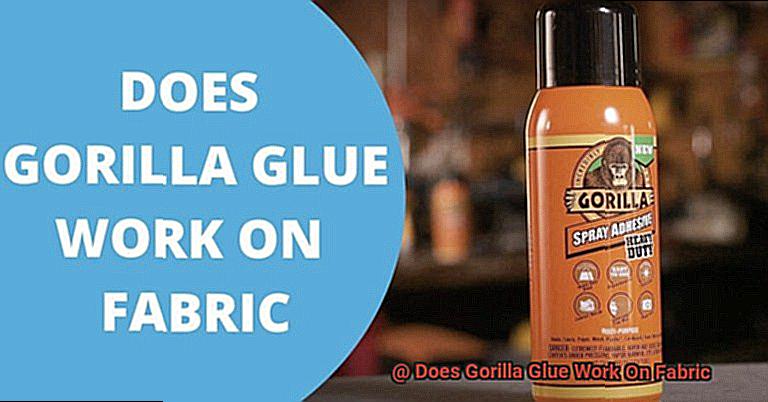
Firstly, delicate fabrics like silk should not be used with Gorilla Glue. Silk fibers are easily damaged by the strong adhesive properties of the glue. Similarly, leather and vinyl may lose their finish and color when bonded with this glue. And if you have water-resistant or waterproof fabrics like nylon or polyester, it’s best to steer clear of Gorilla Glue as it may not adhere properly.
Stretchy or elastic fabrics are also not suitable for bonding with Gorilla Glue. The glue can make the fabric stiff and lose its elasticity. Fabrics with a high percentage of synthetic fibers, such as spandex or Lycra, may also not bond well with Gorilla Glue.
To ensure your fabric projects are successful, it’s best to test a small area first before bonding larger areas. This will help you avoid any damage or discoloration to the fabric. And if in doubt, always consult the manufacturer’s instructions or seek advice from a professional.
Tips for Working with Gorilla Glue and Fabric
Worry not, as we have compiled six critical tips to help you achieve a successful bond between your fabric pieces.
Prepare the Fabric
Before applying Gorilla Glue to fabric, ensure that it is clean and free of any dirt or oils. Wash the fabric with soap and water and allow it to dry completely.
Apply the Glue Sparingly
Gorilla Glue expands as it dries, so only apply a small amount to the fabric to avoid creating excess foam that could potentially damage the fabric.
Use Clamps or Weights
To ensure a strong bond, use clamps or weights to hold the fabric in place while the glue dries. This will help prevent any shifting or movement that could weaken the bond.
Allow Ample Drying Time
Gorilla Glue requires moisture to activate, so spray a small amount of water on the fabric before applying the glue. After applying, allow plenty of time for it to dry completely before handling or wearing the item.
Avoid Using on Delicate Fabrics
While Gorilla Glue can be used on many types of fabric, it’s not recommended for delicate fabrics like silk or lace, as it can damage or discolor them.
Clean Up Excess Glue Immediately
If any excess glue gets on the fabric during application, wipe it away immediately with a damp cloth. Once Gorilla Glue dries, it can be difficult to remove from fabric without causing damage.
By following these tips, you’ll be able to use Gorilla Glue effectively on thick and durable fabrics like denim or canvas. With patience and attention to detail, you can achieve a strong and long-lasting bond between your fabric pieces.
Alternatives to Using Gorilla Glue on Fabric
If you’re searching for alternatives to Gorilla Glue for bonding fabric, there are several options available that may work even better for your needs. Let’s explore some alternatives to consider:
Fabric Glue
First on the list is fabric glue. This type of adhesive is specifically designed for use on fabric and can be found at most craft stores. The best part? It dries clear and flexible, making it an excellent option for use on clothing or other fabric items.
Fusible Tape
Another alternative is fusible tape, a double-sided tape that can bond fabric together without the need for sewing or stitching. It’s activated by heat, so all you need to do is place the tape between two pieces of fabric and use an iron to apply heat and bond the pieces together.
Stitch Witchery
Stitch Witchery is another type of fusible bonding tape that’s ideal for hemming pants or skirts or attaching patches to clothing. You activate it by applying heat, and it can be found at most fabric stores.
Epoxy
While not specifically designed for use on fabric, epoxy can be used in certain situations where other adhesives may not work. When using epoxy on fabric, it’s critical to choose a flexible option that can withstand the washing machine.
Sewing
Finally, sewing is always an excellent option for bonding fabric together. While it may require more time and effort, it ensures a strong and long-lasting bond between fabrics that will stand the test of time.
When considering alternatives to Gorilla Glue for use on fabric, make sure you choose an adhesive option that’s specifically designed for use on fabric or has been tested and proven to work well in this application.
mORL1jJSdlk” >
Conclusion
In conclusion, the answer to the question “Does Gorilla Glue Work On Fabric?” is a resounding yes. However, it’s important to be mindful of a few key factors when using this versatile adhesive. Gorilla Glue can be an excellent choice for repairing clothing or outdoor gear due to its strength and quick-drying time. It’s also affordable and can bond a wide range of fabrics.
But before you start slathering on the glue, there are some potential downsides to consider. Using too much glue can cause it to seep through the fabric or create a hard and rigid finish. And if you’re working with delicate or stretchy fabrics, Gorilla Glue may not be your best option.
To get the best results with Gorilla Glue on fabric, follow these tips: prepare your fabric properly, apply the glue sparingly, use clamps or weights to hold everything in place while it dries, give it ample drying time, avoid using it on delicate fabrics, and clean up any excess glue immediately.
If you’re not sold on using Gorilla Glue for your project, consider alternatives like fabric glue or fusible tape. With patience and attention to detail, you’ll achieve a strong and long-lasting bond between your fabric pieces no matter which method you choose.

